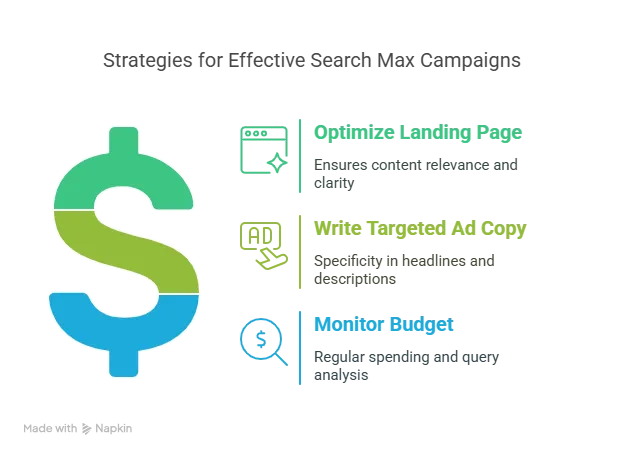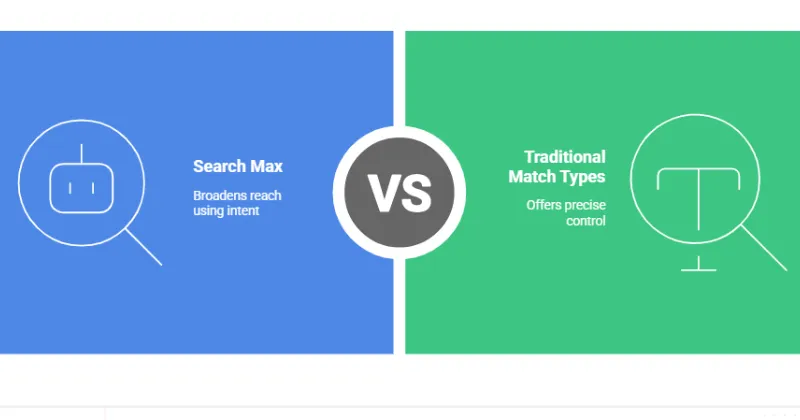Google Ads is all about connecting businesses with the right audience, and the primary concept behind this is the keyword match type. For years, advertisers have relied on three main keyword match types—broad match, phrase match, and exact match—to control how their ads appear in search results. However, Google is now shaking things up by introducing a new keyword match type called Search Max. This article will explain what Search Max is, how it differs from the existing options, and how you can prepare for it in simple terms.
What Are Keyword Match Types in Google Ads?
Before diving into Search Max, let’s quickly refresh our understanding of the current keyword match types. These options decide how closely a user’s search query must match your chosen keyword for your ad to show up.
- Broad Match: This is the widest net you can cast. If your keyword is “IIT JEE Coaching Center,” your ad might appear for searches like “best IIT coaching near me” or “JEE preparation classes in Delhi.” It offers less control but reaches more people.
- Phrase Match: This gives you a bit more control. Using the same keyword, “IIT JEE Coaching Center,” your ad could show for “best IIT JEE Coaching Center near me” or “IIT JEE Coaching Center in Delhi,” as long as the phrase stays intact.
- Exact Match: This is the strictest option. Your ad will only appear for searches like “IIT JEE Coaching Center” or very close variations, giving you maximum control but limiting your reach.
These three have ruled Google Ads for a long time, especially in the pre-AI era. But with AI advancements, things are changing, and Search Max is the latest step in that direction.
What Is Search Max and How Does It Work?
Search Max is Google’s newest keyword match type, set to launch soon. Unlike broad match, phrase match, and exact match—where you have varying levels of control—Search Max hands most of that control over to Google. It uses not just your keyword but also your ad text, landing page content, and even the URL to decide when and where your ad appears.
For example, if your keyword is “IIT JEE Coaching Center” but your landing page mentions “NEET preparation” or a testimonial uses the word “NEET,” your ad might show up for NEET-related searches too. Google will analyze everything—your ad headline, description, landing page text, and URL—to match your ad with a broader audience based on intent, not just exact words.
Benefits and Challenges of Search Max
Search Max comes with both advantages and risks. On the positive side, it can help your ad reach more people, even if you didn’t pick the perfect keyword. If your landing page and ad text are well-written and targeted, Google’s AI can find the right audience for you. This is great for beginners or those who struggle with keyword research.
However, there’s a downside. If your landing page or ad copy is vague or poorly written, your ad might appear for unrelated searches, wasting your budget. For instance, a sloppy landing page could trigger your ad for irrelevant queries, costing you money without results. With Search Max, Google takes the wheel, which might not always align with your goals.
Google’s New “Identity Check” Feature for Android 15 and Pixel Phones: A Game-Changer for Security
How to Prepare for Search Max
To make the most of Search Max, you need to adapt. Here are some simple tips:
- Optimize Your Landing Page: Make sure your landing page content is clear, relevant, and matches your target audience’s intent. A strong landing page can guide Google to show your ad to the right people. Learn more about landing page optimization from HubSpot.
- Write Targeted Ad Copy: Your ad headline and description should be specific to what you offer. Avoid generic phrases to prevent mismatched queries.
- Monitor Your Budget: Since Search Max reduces your control, keep an eye on your spending. Check your search terms report regularly to see what queries trigger your ad and adjust as needed.

Why Is Google Introducing Search Max?
Google’s move to launch Search Max seems to be about two things: improving AI-driven advertising and increasing its own revenue. By taking more control, Google can use its advanced algorithms to match ads more broadly, which might mean more ad clicks—and more income for them. However, this could also impact professionals who rely on fine-tuned campaigns, as it simplifies the process but reduces manual oversight.
Final Thoughts on Search Max
The introduction of Search Max marks a big shift in how Google Ads works. While broad match, phrase match, and exact match have been the foundation for years, Search Max brings a new, AI-powered approach. It’s exciting for those who want simplicity and wider reach, but it requires careful preparation to avoid pitfalls. For more insights on Google Ads trends, check out Search Engine Journal.
As this new keyword match type rolls out, stay proactive. Test it, tweak your campaigns, and see how it fits your strategy. Are you ready to embrace Search Max?

